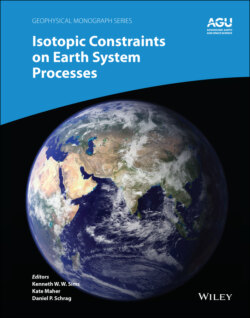Читать книгу Isotopic Constraints on Earth System Processes - Группа авторов - Страница 46
ABSTRACT
ОглавлениеLaboratory experiments were used to investigate diffusive isotopic fractionation of calcium and potassium in phonolite‐rhyolite diffusion couples. The starting compositions have very different SiO2 and K2O, but similar CaO. These were juxtaposed and held in a completely molten state at 1450°C and 1.0 GPa for durations of 2.5 or 6 hours in a piston cylinder apparatus. The resulting major‐element diffusion profiles exhibit many complexities, including uphill diffusion of all major oxide components. The diffusive fluxes for SiO2, K2O, and CaO were modeled using a published modified effective binary diffusion model, whereby diffusion is driven by activity gradients that are solely a function of the time‐evolving SiO2 concentration. Both Ca and K exhibit large diffusive isotope effects that can be explained by imposing a mass dependence on the diffusion coefficients used to model the major‐element profiles. The mass dependence is parameterized in terms of the inverse ratio of the isotope masses raised to an empirically determined exponent β (i.e., Di/Dj = [mj/mi] β ). Our results confirm that β factors vary depending on the element as well as liquid composition, and that large diffusive isotope effects can arise even in the absence of a large initial concentration gradient. The retrieved β factor for Ca (0.10 ± 0.02) is typical of Ca in natural silicate liquids, whereas the β factor for K (0.25 ± 0.03) is the highest value yet reported, suggesting that large diffusive K isotope effects may yet be found in high‐T environments.
